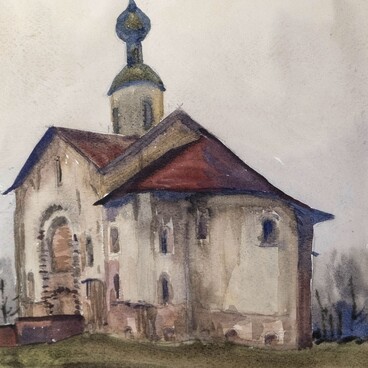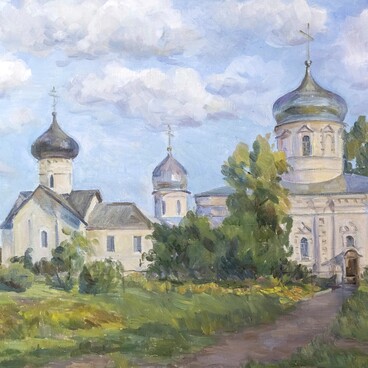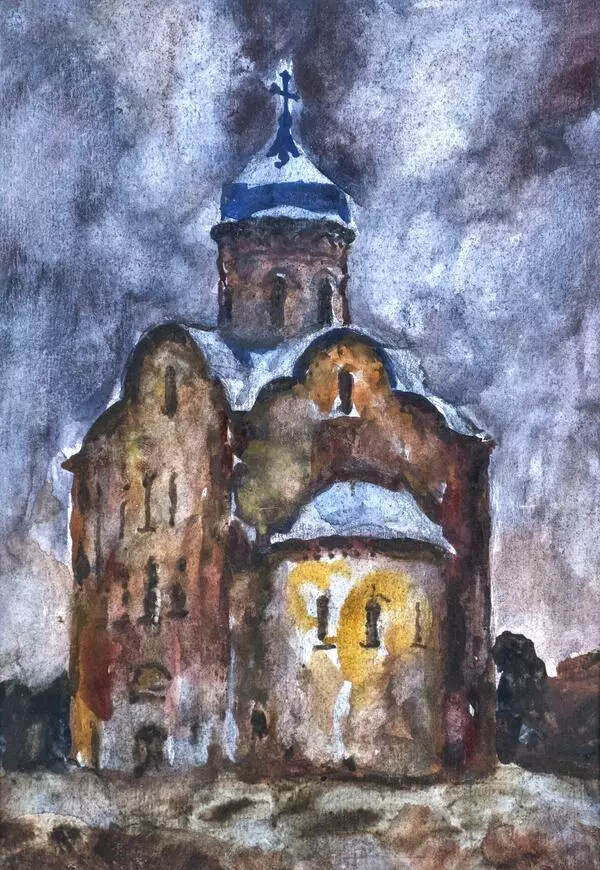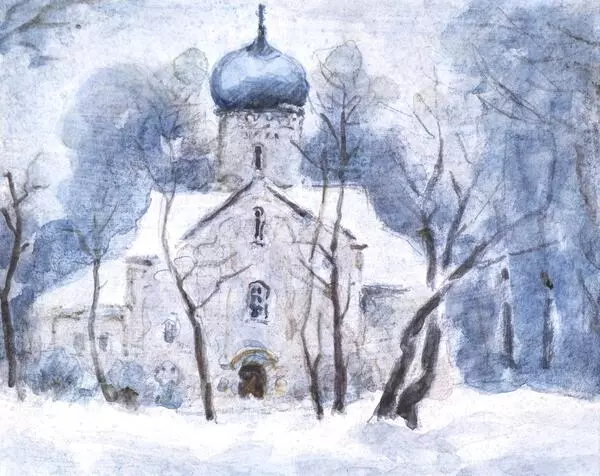The stone Church of St. John the Theologian on the Vitka was laid in 1383. In 1384, when the construction was completed, it is mentioned in a chronicle as the main church belonging to a small Theological Convent, which was an “ordinary” one. When the convent was abolished in 1764, it became a parish church and continued to function.
The church was named after the Vitka River, which back then flowed into the Volkhov River in that area.
It is a rectangular building with one dome and three aisles; its architectural features and stone crosses embedded into walls are characteristic of the Novgorod architectural tradition of the second half of the 14th century. The top parts of the facades, which had featured a pattern of three pilaster strips, were replaced with gable ends.
In the 16th century, the western porch with a warm chapel (with heating) consecrated in honor of the Assumption was added to the church. In 1799, a small bell tower in the classical style appeared there instead.
In the mid-1920s, services in the church stopped, its premises were used as a warehouse for a boat station, and the bell tower was dismantled into bricks for the construction of the city power plant. The building was significantly damaged during the Great Patriotic War and in the late 1940s, when it was struck by lightning.
In 1952, under the supervision of the architect Lyubov Mitrofanovna Shulyak, the church was restored.
In 2000, at the request of the Novgorod Old Believers, the bishop of the Russian Orthodox Old Believers Church, Alimpius (Gusev), blessed Father Alexander Pankratov to organize a parish and revive the church.
After that, long-term restoration works continued, mainly at the expense of the church community. It was possible to renovate the exterior of the walls and the foundation, to repair the refectory and the central rooms. Under a layer of plaster, the restorers found medieval graffiti, that is, inscriptions and drawings. The original templon — a low barrier with icons attached to it —was also partially restored.
In 2004, the church was solemnly consecrated by Archbishop of Kyiv and All Ukraine Savaty (Kozko). Today it is a functioning Old Believer church.
The painting is one of Semyon Ivanovich Pustovoytov’s watercolors dedicated to the history and revival of Veliky Novgorod. The artist, who fought in the Novgorod region and saw the city in ruins, acutely conveys in his work the idea that architectural monuments are the fate, history and future of the people.
The church was named after the Vitka River, which back then flowed into the Volkhov River in that area.
It is a rectangular building with one dome and three aisles; its architectural features and stone crosses embedded into walls are characteristic of the Novgorod architectural tradition of the second half of the 14th century. The top parts of the facades, which had featured a pattern of three pilaster strips, were replaced with gable ends.
In the 16th century, the western porch with a warm chapel (with heating) consecrated in honor of the Assumption was added to the church. In 1799, a small bell tower in the classical style appeared there instead.
In the mid-1920s, services in the church stopped, its premises were used as a warehouse for a boat station, and the bell tower was dismantled into bricks for the construction of the city power plant. The building was significantly damaged during the Great Patriotic War and in the late 1940s, when it was struck by lightning.
In 1952, under the supervision of the architect Lyubov Mitrofanovna Shulyak, the church was restored.
In 2000, at the request of the Novgorod Old Believers, the bishop of the Russian Orthodox Old Believers Church, Alimpius (Gusev), blessed Father Alexander Pankratov to organize a parish and revive the church.
After that, long-term restoration works continued, mainly at the expense of the church community. It was possible to renovate the exterior of the walls and the foundation, to repair the refectory and the central rooms. Under a layer of plaster, the restorers found medieval graffiti, that is, inscriptions and drawings. The original templon — a low barrier with icons attached to it —was also partially restored.
In 2004, the church was solemnly consecrated by Archbishop of Kyiv and All Ukraine Savaty (Kozko). Today it is a functioning Old Believer church.
The painting is one of Semyon Ivanovich Pustovoytov’s watercolors dedicated to the history and revival of Veliky Novgorod. The artist, who fought in the Novgorod region and saw the city in ruins, acutely conveys in his work the idea that architectural monuments are the fate, history and future of the people.






